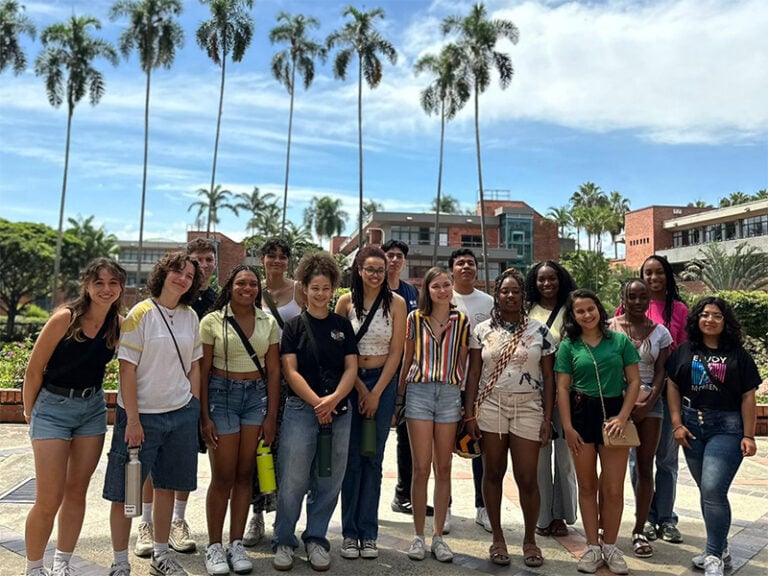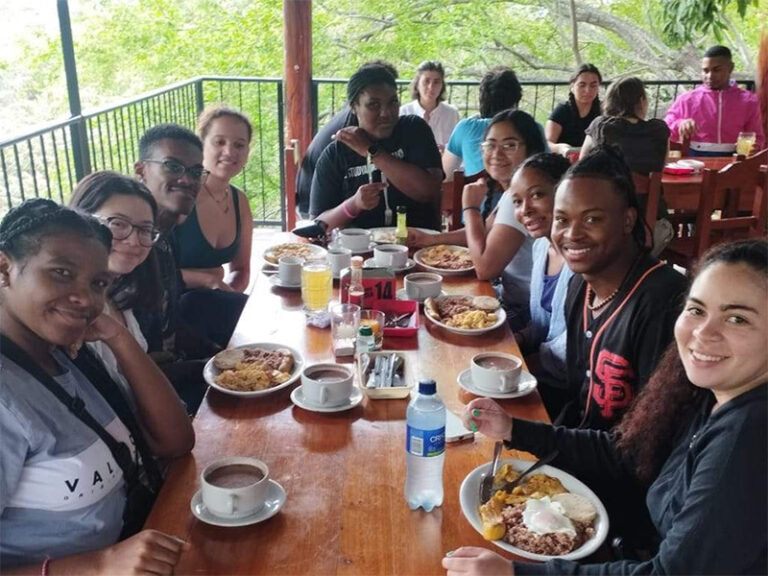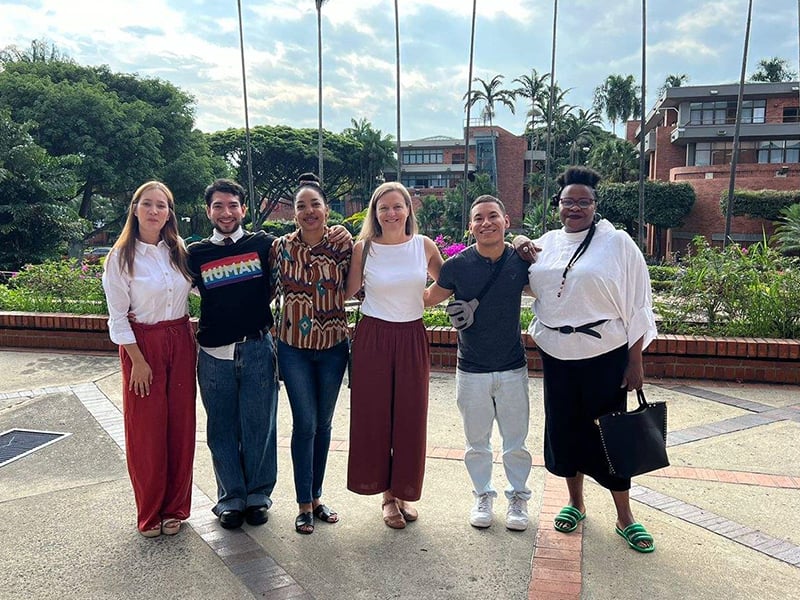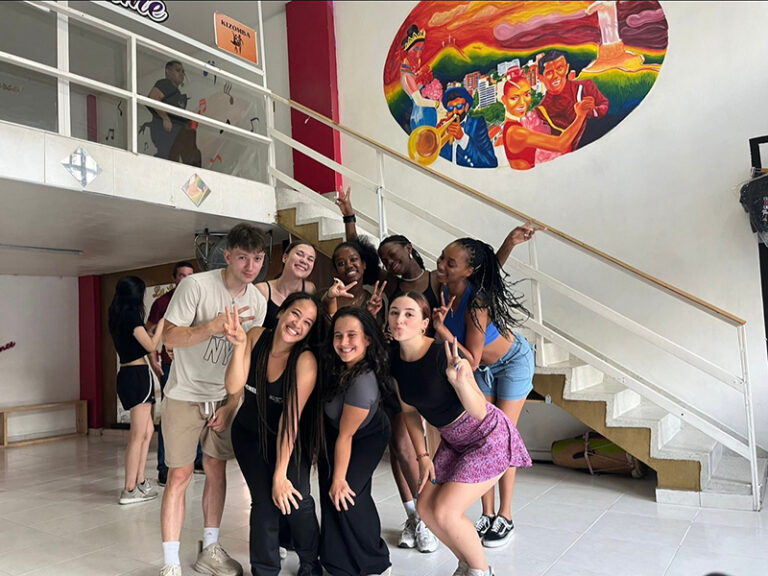Our goal is to offer every course every term, but sometimes factors like faculty availability, student course rankings, and program enrollment keep us from reaching that goal. If you’re concerned about needing to enroll in one particular course, please contact us!
CET Colombia Study Abroad
CET Colombia: At-A-Glance
Study race, ethnicity, and identity
Spanish language electives
Live with a Colombian roommate
Direct-enroll electives
Traveling Seminar to the Caribbean coast
Out-of-class learning and assignments
Fall
- Arrival: 07/21/2025
- Departure: 11/29/2025
- Recommended Credits: 15-18
- Fee: $16,990
- Application Deadline: April 1
SPRING
- Arrival: 01/19/2026
- Departure: 05/30/2026
- Recommended Credits: 15-18
- Fee: $16,990
- Application Deadline: November 1
Fall
- Arrival: 07/21/2025
- Departure: 11/29/2025
- Recommended Credits: 15-18
- Fee: $16,990
- Application Deadline: April 1
SPring
- Arrival: 01/19/2026
- Departure: 05/30/2026
- Recommended Credits: 15-18
- Fee: $16,990
- Application Deadline: November 1
CET Colombia study abroad students study race, identity, and ethnicity through the Afro-Colombian lens in Cali—a city with the second largest population of African descent in South America. The program’s curriculum, developed in consultation with Howard University, allows you to examine these dynamics through sociopolitical, economic, artistic, and historical representations of race in Colombia. And with out-of-class learning, local roommates, and direct-enroll classes that put you in a Colombian classroom, you grow your understanding both intellectually and experientially.
Academics in Colombia
Semester
Snapshot
- Pre-requisites: None
- Electives in both English and Spanish
- Traveling Seminar to San Basilio de Palenque and Cartagena
- Spanish language classes for all levels
- Direct-enroll electives for intermediate and advanced Spanish speakers
- Host University: Universidad Autónoma de Occidente (UAO)
Choose your Spanish Level
All levels of Spanish speakers are welcome at CET Colombia, but your proficiency level determines your curriculum.
Curriculum & Syllabi:
BEGINNING & INTERMEDIATE SPANISH
Beginning and intermediate-level Spanish speakers take one core course, a Spanish course, one direct-enroll course, and two or three CET electives to meet the total 15 to 18 recommended credits.
Core Course
You take this 3-credit course that is taught exclusively for CET students. This course is initially taught in English, but as your language skills improve, your teachers introduce more Spanish instruction.
CA/SOCI 330 Race and Identities: Debates in the Colombian Context
Spanish as a Foreign Language
You take this 3-credit course taught exclusively for CET students.
Direct-Enroll Course at UAO
You take this 3-credit elective taught in English at Universidad Autónoma de Occidente
History of Armed Conflict in Colombia
CET converts final grades from the local host universities to US letter grade equivalents.
CET Electives
You take two or three CET electives to meet the total 15 to 18 recommended credits. These 3-credit electives are exclusively for CET students in English or Spanish.
Area Studies
CA/ANTH 330 The Cultures of Afro Descendants in Colombia (taught in Spanish)
CA/CLTR 340 A Social History of Colombian Coffee
CA/GEOG 310 Environmental Conflicts, Territorialities, and Ethnic Groups in Colombia
CA/POLI 320 Reclaiming Blackness: Social and Political Movements in Colombia (taught in Spanish)
CA/SOCI 315 Crime & Justice in Colombia
Curriculum & Syllabi: ADVANCED SPANISH
Advanced-level Spanish speakers take one core course, at least one direct-enroll elective at UAO, and three or four additional electives to meet the total 15 to 18 recommended credits.
Core Course
You take this 3-credit course that is taught exclusively for CET students. This course is taught in a combination of English and Spanish.
CA/SOCI 330 Race and Identities: Debates in the Colombian Context
Electives
You take at least one direct-enroll elective at UAO for 3 credits, then choose three or four additional electives to meet the total 15 to 18 recommended credits.
CET Electives
These 3-credit electives are exclusively for CET students in English or Spanish.
Area Studies
CA/ANTH 330 The Cultures of Afro Descendants in Colombia (taught in Spanish)
CA/CLTR 340 A Social History of Colombian Coffee
CA/GEOG 310 Environmental Conflicts, Territorialities, and Ethnic Groups in Colombia
CA/POLI 320 Reclaiming Blackness: Social and Political Movements in Colombia (taught in Spanish)
CA/SOCI 315 Crime & Justice in Colombia
Spanish Language as a Foreign Language
Direct-Enroll Electives at UAO
These are elective courses taught at one of the program’s host universities, Universidad Autónoma de Occidente. Most classes 3 credits each, taught in Spanish (unless otherwise noted), and offer the opportunity to learn alongside Colombian undergraduates and learn as local students do. To enroll in Spanish-taught courses at UAO, students must have achieved C1/advanced Spanish language proficiency on the CET language placement test. Course offerings differ each semester, but CET students have full access to UAO’s undergraduate courses, provided you meet any specific pre-requisites. Past courses have included:
Universidad Autónoma de Occidente (UAO):
History of Armed Conflict in Colombia (taught in English)
Identities & Culture
Cinema, Memory, & Peace
Social Anthropology of Valle del Cauca
Music & Cultural Identity in Colombia
Public Relations (Organizational)
CET converts final grades from the local host universities to US letter grade equivalents.
Curriculum & Syllabi
BEGINNING & INTERMEDIATE SPANISH
Beginning and intermediate-level Spanish speakers take one core course, a Spanish course, one direct-enroll course, and two or three CET electives to meet the total 15 to 18 recommended credits.
Core Course
You take this 3-credit course that is taught exclusively for CET students. This course is initially taught in English, but as your language skills improve, your teachers introduce more Spanish instruction.
CA/SOCI 330 Race and Identities: Debates in the Colombian Context
Spanish as a Foreign Language
You take this 3-credit course taught exclusively for CET students.
Direct-Enroll Course at UAO
You take this 3-credit elective taught in English at Universidad Autónoma de Occidente
History of Armed Conflict in Colombia
CET converts final grades from the local host universities to US letter grade equivalents.
CET Electives
You take two or three CET electives to meet the total 15 to 18 recommended credits. These 3-credit electives are exclusively for CET students in English or Spanish.
Area Studies
CA/CLTR 340 A Social History of Colombian Coffee
CA/GEOG 310 Environmental Conflicts, Territorialities, and Ethnic Groups in Colombia
CA/SOCI 315 Crime & Justice in Colombia
CA/POLI 320 Reclaiming Blackness: Social and Political Movements in Colombia (taught in Spanish)
CA/ANTH 330 The Cultures of Afro Descendants in Colombia (taught in Spanish)
ADVANCED SPANISH
Advanced-level Spanish speakers take one core course, at least one direct-enroll elective at UAO, and three or four additional electives to meet the total 15 to 18 recommended credits.
Core Course
You take this 3-credit course that is taught exclusively for CET students. This course is taught in a combination of English and Spanish.
CA/SOCI 330 Race and Identities: Debates in the Colombian Context
Electives
You take at least one direct-enroll elective at UAO for 3 credits, then choose three or four additional electives to meet the total 15 to 18 recommended credits.
CET Electives
These 3-credit electives are exclusively for CET students in English or Spanish.
Area Studies
CA/CLTR 340 A Social History of Colombian Coffee
CA/GEOG 310 Environmental Conflicts, Territorialities, and Ethnic Groups in Colombia
CA/SOCI 315 Crime & Justice in Colombia
CA/ANTH 330 The Cultures of Afro Descendants in Colombia (taught in Spanish)
Spanish Language as a Foreign Language
Direct-Enroll Electives at UAO
These are elective courses taught at one of the program’s host universities, Universidad Autónoma de Occidente. Most classes 3 credits each, taught in Spanish (unless otherwise noted), and offer the opportunity to learn alongside Colombian undergraduates and learn as local students do. To enroll in Spanish-taught courses at UAO, students must have achieved C1/advanced Spanish language proficiency on the CET language placement test. Course offerings differ each semester but past courses have included:
Universidad Autónoma de Occidente (UAO):
The Colombian Pacific Region: History and Culture (taught in English)
Identities & Culture
Cinema, Memory, & Peace
Social Anthropology of Valle del Cauca
Music & Cultural Identity in Colombia
Public Relations (Organizational)
CET converts final grades from the local host universities to US letter grade equivalents.

Dive Deep in Colombia
Experiential learning in Cali. As a city that celebrates Blackness as one of its defining features, Cali is the perfect home base to explore race, ethnicity, and identity, both in and out of the classroom. Depending on your electives, you might explore the consequences of exploitation by international companies at Farallones National Park, learn the basics of esgrima de machete y bordón (traditional martial art of stick fighting that has become a symbol of resistance), or even host Proudly Afro-Colombian: A Discussion Series by facilitating a public discussion with prominent artists, scientists, or activists.
Spanish language immersion. Get ready to challenge your Spanish skills like never before. Navigate life in a city that speaks English minimally, take a Spanish class, and—for more advanced speakers—study alongside local Colombian undergraduates with direct-enroll coursework at Universidad Autónoma de Occidente (UAO).
Traveling Seminar: Comparative Learning
Take learning on the road as you spend seven days exploring concepts from your core course in San Basilio de Palenque and Cartagena. You might:
• Stay with a host family in Palenque, a maroon settlement with a long history of resistance and resilience. Learn about customs, traditions, and daily life, then help out with a community project chosen by locals.
• Learn about the local, no-police justice system from La Guardia Cimarrona and community elders. Then meet with Mujeres Palenqueras to explore reinforcing identity through beauty, clothing, and braids.
• Attend a ballroom workshop to examine Afro-Colombian identity and self-love as resistance in the colonial city of Cartagena.
• Head to La Boquilla and speak with locals to learn about the negative effects of rapid-growth tourism for livelihoods dependent upon fishing.
Housing and Meals
- Apartment
- Off-Campus Housing
- Live with CET peers & local roommates
- 3-4 people/apartment
- 2 people/room
- Fully equipped kitchen, bathroom, living room, dining room, 2-in-1 washer and dryer
- Wifi access, linens, basic furnishing, kitchenware, fans
Living Like a Local
Local Roommates. Want to learn where to find the best manjar blanco (Colombian dulce de leche)? Which restaurant to eat at in Parque del Perro? How to navigate the local bus system? Sharing your apartment with students from Universidad del Valle gives you insider’s access to the city and brings language and local culture out of the classroom and into your home life. Learn more about living with a local roommate.
Eating in Cali. For meals, take your pick of Cali’s many inexpensive eateries. Find your favorite arepa spot or savor a bowl of sancocho, a hearty soup made with chicken, potatoes, plantain, herbs, corn, and avocado. Feeling like a home-cooked meal? Grab ingredients at the supermarket and have a big night in with your roommates. Learn more about accommodating your dietary needs in Cali.

Life in Cali

- Known locally as: Cali
- Population: 2.4 million
- Local Currency: Colombian Peso
- Known for: Salsa capital of the world, Second largest Black population in South America, Cristo Rey, Festival Petronio Álvarez
In a city where the influences of diversity are ever-present, your everyday surroundings will inform your studies and Cali’s active calendar of cultural activities will fill your days. Enjoy a cold champú (refreshing local drink) as you relax in town. Use your Spanish to befriend the barista at your favorite café. Go dancing with friends at Calle de la Salsa, a community salsa event at Boulevard del Río. Spend the weekend at the mountains or on the beach with your roommate. Or stay nearby and listen to live music at Loma de la Cruz or swim in the many rivers across Cali—a favorite weekend pastime of Caleños.
Experience Cali with CET
Around the city. Each term, the program offers different extra-curricular activities that allow you to explore Cali and Colombian culture. Try your hand at salsa with a workshop in the city’s iconic Obrero neighborhood. Have a refreshing cholado (a fresh fruit salad with condensed milk served over shaved ice) at Panamericana’s Canchas. And there’s even more to see on your own.
A Weekend Away. Head to San Cipriano, a nature reserve with a small Afro-Colombian fishing village along the Danubio River. Explore the small town. Meet with locals to discuss how tourism impacts their community and understand what challenges they face in their daily lives. Then relax with a hike to a waterfall and and a dip in the river.
Volunteer in Cali. Consider giving back to the community with a 4 to 6 hour weekly commitment. You might help a women-led organization increase access to education or support youth leadership efforts in the city’s most vulnerable areas.
Student Resources
"Though folks in the program had been taking trips around the country independently from the study abroad program, the Traveling Seminar was the perfect opportunity to spend time as a collective while furthering our understanding of how the Afro-Colombian experience varies by region."
— Karen Garcia-Ramos,
Pomona College | Spring student
READ KAREN'S BLOG— Karen Garcia-Ramos,
Pomona College | Spring student
"During my time abroad, I delved into the study of race, identity, and ethnicity through the Afro-Colombian perspective in Cali—a city with the second-largest population of African descent in South America. I had excellent professors who taught me so much. The Traveling Seminar to San Basilio de Palenque and Cartagena was also an incredible experience."
— Ashari James,
Howard University | Spring student
— Ashari James,
Howard University | Spring student
"A few times a week, we have group dinners and someone cooks a meal of their choice. For this night our Colombian roommate, Sharick, decided to make us a Colombian meal her and her family eat: arroz con papa y huevos pericos. Living with a Colombian roommate that is around our age is so fun and truly an adventure everyday."
— Jada Jackson,
Howard University | Fall student
READ JADA'S BLOG— Jada Jackson,
Howard University | Fall student
"Language study at CET Colombia is so rewarding. I started with no Spanish. Now, I am at a level of practical intermediacy. I have made friends and met with professors in Spanish, despite having never taken it before this program."
— Noah Rowan,
Clark University | Spring student
— Noah Rowan,
Clark University | Spring student
"While most of CET’s classes are hosted in-house, there are plenty of out-of-class activities, projects, and field trips. By the end of our first week of class, we had a 4-person group project to remake an Afro-Colombian dish which included a trip to a local farmer’s market."
— Maya Martin,
Howard University | Spring student
READ MAYA'S BLOG— Maya Martin,
Howard University | Spring student
"My time in Colombia was amazing! I learned so much about Afro-Colombian culture, Colombian history, and society as a whole. This program not only allowed me to learn about new places and cultures but also forced me to be introspective and learn new things about my own identity."
— Amara Payne,
George Washington University | Spring student
— Amara Payne,
George Washington University | Spring student
On-the-ground support
Navigating a new city, country, and culture is a big challenge worth taking—and we’re here to help you along on this adventure. Our on-site team is bilingual, thoughtful about guidance and support, and is passionate about sharing their love of Cali (and Colombia!) with you.

Program Fees
Fall/Spring
$16,990
What's Included
Tuition
All of your classes and program-related learning are included with your tuition.
Housing
We arrange your housing in a fully-furnished apartment about a 15 to 20 minute walk from campus. Your program fees go toward rent, utilities, furnishing, and other management costs.
Traveling Seminar
We cover your transit, housing, and most meals during your Traveling Seminar to Cartagena and Palenque. Don’t forget to bring a camera and your curiosity.
Activities & Excursions
The activities and excursions that we arrange are included in your program fee. All you need to do is remember to bring your camera!
Staff Support
From pre-departure to orientation, from on site to re-entry, CET provides you with the support you need every step of the way.
Insurance
You’re provided with a comprehensive insurance plan through GeoBlue that even includes medical evacuation coverage.
Visa Support
We guide you step-by-step through the visa process. Most nationalities (including US citizens) can receive a visa exemption on arrival at the airport, and we’ll help you finalize your status on-site to cover the full program dates.
Course Materials
Your textbooks and course supplies are covered and waiting for you on site.
Transcript
At the end of your term, you’ll receive academic documentation as proof of all you’ve accomplished abroad. Depending on your home institution, you will either get a CET grade report or a School of Record transcript from the University of Minnesota.
More on finances

Program Fee Breakdown. Of the total program fee, $13,760 goes to tuition and fees, and $3,230 goes to housing and other student life fees.
Local Cost of Living. The cost of living in Colombia is considerably more affordable than that of the US. An average cost of living is estimated at 350 USD/month, though this varies depending on how often students eat at restaurants and/or participate in nightlife.
Estimated out-of-pocket expenses:
- Round-trip Airfare: $800
- Meals: $1,200
- Personal Expenses: $900
- Housing Deposit: $150
- Printing Costs: $50
additional resources
How to Apply
Eligibility
- • Pre-requisites: None. Open to students of any Spanish level, but students with more Spanish language experience have more curricular flexibility.
- • Must be 18 or older at the time of program participation.
- • Open to students from any US college or university
- • GPA: 3.0 or higher is recommended, students with lower GPAs will be asked for a faculty recommendation to supplement their application
Online Application Form
This is a brief form that asks for basic information and has a few short answer questions about why you want to study abroad.
Passport Information
Upload a scan of your passport to your CET Compass account. This should be a single scan that includes the signed signature page and the photo/personal details page. Don’t have a passport yet? Let us know and we can help advise you.
Study Abroad Office Recommendation
This is an online form that your study abroad office completes to let us know you meet the requirements to study abroad. To send the electronic form request, simply enter the name and email address of your study abroad advisor in the designated fields of your CET Compass account.
Official Transcript
Your CET Compass account has specific instructions for submitting an official transcript.
Application
Deadlines
Spring Semester:
November 1
Fall Semester:
April 1

Have a question? Get in touch!
Gabrielle Jackson
Manager, Student Services
202.315.0238
[email protected]
Price Subject to Change:
CET reserves the right to increase quoted charges at any time without prior notification, based on increased instruction costs, exchange rate fluctuation or other cost increases beyond CET’s control.